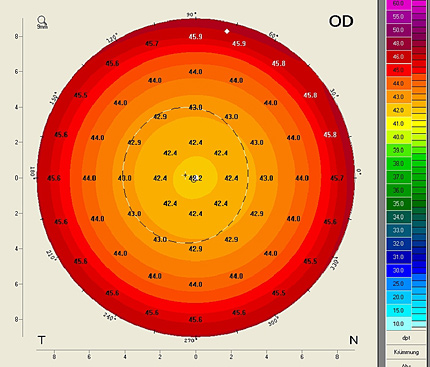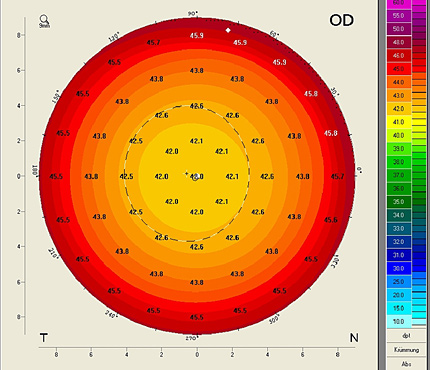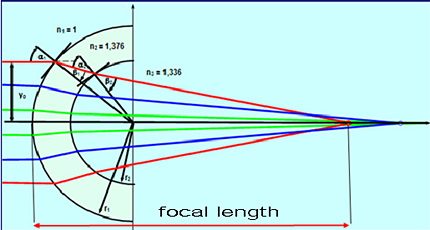Corneal Placido Topographers measures geometrical corneal slope values.
These values are converted into curvature values e.g. Axial (Sagittal) curvature or
Instantaneous (Tangential) curvature. These curvature radius values are firstly mm-values.
The Pentacam® measures geometrical “Height (elevation)” values. These values are converted into curvature values Axial (Sagittal) curvature or Instantaneous (Tangential) curvature.
Also these curvature radius values are firstly mm-values.
It is very common to use these geometrical radius (mm) values and convert it into optical power values in Diopter. Normally a simple formula is used to convert a mm value
into Diopter: Dpt=(1.3375-1)*(1000)/Rmm.
The Refractive Effect
A sphere has the same radius of curvature at every position, but due to the spherical aberration the refractive power is not the same everywhere. If the effect of the spherical aberration is not taken into account a corneal sphere with a radius of, say, 7.5 mm would have the same refractive power of 45 diopters at every position (using the keratometer calibration index of 1.3375, see below). Due to the spherical aberration, however, the refractive power in the periphery is actually higher. The so-called “Refractive Maps” of the Pentacam® are calculated using Snell’s law of refraction using exact ray tracing and therefore take this effect into account.
Inclusion of Anterior/Posterior Surface
By convention most keratometers use the refractive index of 1.3375 when calculating the dioptric power from the anterior radius assuming the cornea were a single refracting surface. However, it has been known for quite some time, that this keratometric index is not the best approximation for the true, physiological power of the cornea. Due to the contribution from the posterior surface and the true refractive index of the cornea (ncornea=1.376) the true net power of the cornea which can be calculated using ‘thick-lens’ models or using exact ray tracing is lower than the value reported by standard keratometry. The deviation between true net power and standard keratometry becomes even worse when dealing with corneas after excimer laser ablation (LASIK, LASEK, PRK) of the front surface. Therefore after refractive corneal surgery, the calculation of the corneal refractive power based only on the anterior surface can no longer be used, as the ratio between the anterior and the posterior radius of the cornea changes considerably.
The Refractive Index
For historical reasons, most Placido topographers and keratometers use the refractive index of 1.3375 for the refractive power of the cornea. This refractive index is actually incorrect even for the untreated eye (n~1,332) and assumes a constant ratio between the anterior and posterior curvature of the cornea. As many IOL power calculation formulas use the incorrect ‘K-reading’ directly an empirical correction is needed in the end to adjust the correct IOL power in these formulas even in normal cases. Care should be taken, however, when using ‘K-readings’ from post-LASIK corneas or based on true net power or ray tracing, as these diopter readings are out-of-range for these IOL calculation formulas if not corrected for or converted into ‘equivalent’ K-readings. Some modern formulas are able to deal with the true, measured curvatures of the front and back surface of the cornea, however.
Location of Principle Planes
If ray tracing is used to calculate the corneal power parallel light is sent through the cornea. Each light beam is refracted according to the correct refractive index (1.376/1.336), the slope of the surfaces, and the exact location of the refraction. This is necessary because the anterior and posterior surface have principal planes that are located slightly different (corneal thickness).
The Pentacam® can measure the anterior and also the posterior surface of the cornea. With this further corrections can be done. The Pentacam® does provide different maps to predict corneal power:
Sagittal Power Map

This is the common “Placido Style Map”. 1.3375 and the simple formula “Dpt=(1.3375-1)*(1000)/Rmm” is used to calculate corneal power. So this map shows similar power values like other Placido topographers.
Refractive Power Map
This map uses only values from the anterior surface, but the effect A (see above) is taken into account. 1.3375 is used but the calculation uses Snell’s law of refraction. This is a map that other Placido Topographers also may show, because it based only on the anterior surface.
 True Net Power
True Net Power
This map shows the optical power of the cornea, by using correct refractive index and by using sagittal curvature values from the anterior and the posterior surface. The refractive index of the cornea tissue 1.376 is used for calculating the anterior power and with 1.336 (refractive index of aqueous) the posterior power is calculated. Then these results are added. So in that map effect “B” is taken into account. The equation used:
![]()
Equivalent K-Reading Power Map
This map was designed to take into account the refractive effect and the effect of the posterior surface, but the map should output power values (EKR) that are in normal cases (no Lasik) comparable with SimK, which are usually derived from the Sagittal Map. The power calculation uses the correct refractive index of the corneal tissue and the aqueous. Snell’ law is used to calculate the power. The result of anterior power and posterior power are added. After that, the map is shifted, so that for a normal eye (posterior radius 82% of anterior radius) the K-values “EKR” would match the SimK of a Sagittal Map. In other words, the error that 1.3375 would create to a sagittal map is now added to that EKR-Map. This is done, because such a map provides K-values (EKR), that can be used in IOL-formulas that correct for 1.3375. So this map takes into account of effect “A”, “B” and “C”.

Total Corneal Refractive Power Map
This map uses ray tracing to calculate the power. Parallel light is send to the cornea, the light beams are refracted according to the correct refractive index (1.376/1.336), the slope of the surfaces, and the exact location of the refraction. This is necessary because the anterior and posterior surface has principal planes that are located slightly different (corneal thickness). In this map effect “A”, “B”, “C” and “D” are taken into account. The result of this map is the most realistic, but this result will deviate from “normal (sagittal) Sim K’s” so it can not be used in historical IOL formulas.